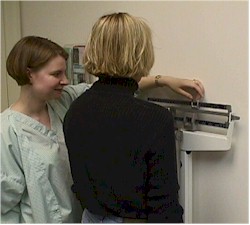
|
Lesson 4: Vital Signs
Soon after a patient arrives on the nursing unit you should begin your nursing assessment. You should take several measurements to establish a baseline for further observations of that patient. Among these measurements are height, weight, and vital signs. The vital signs are the body temperature, the pulse or rate of heartbeats, the respiration or rate of breathing, and the blood pressure. The vital signs are abbreviated TPR and BP for temperature, pulse, respirations and blood pressure. These readings are called vital signs because they all must be present for life to continue.
The patient's height and weight are recorded on admission for several reasons.
a. Diet Management. The patient's ideal weight may be determined. The health care team will also be able to monitor weight loss or gain.
b. Observation of Medical Status. Taking the patient's height and weight may indicate that the patient is overweight, underweight, or is retaining fluids (edema). The health care team can observe changes in weight caused by specific disease processes and determine the effectiveness of nutrition supplements prescribed to maintain weight.
c. Calculation of Medication Dosages. Drug dosage is often prescribed in relation to a patient's weight when a specific blood concentration of the drug is desired. Larger doses may be required in a heavier person.
4-3. MEASURING HEIGHT AND WEIGHING THE PATIENT
a. To measure height, have the patient stand on the scale with the back to the measuring bar.
b. Ask the patient to stand straight. Lower the bar so that it lightly touches the top of the patient's head.
c. Record the height in inches or centimeters in accordance with local policy.
d. If the patient cannot stand, obtain an approximate height in bed.
(1) Have the patient lie on his back and stretch as much as possible.
(2) Place a mark on the bottom sheet at the patient's heel and at the top of the patient's head.
(3) Measure between these two marks on the taut bottom sheet.
e. Principles related to weighing the patient.
(1) Weigh the patient before breakfast, at the same time each day.
(2) Use the same scale each time.
(3) Ensure that the scale is properly balanced.
(4) Weigh the patient in the same amount of clothing each day (i.e., hospital gown or pajamas).
(5) Have the patient void before weighing.
(6) Avoid weighing any equipment attached to the patient such as drainage bags or telemetry units. Hold the equipment while actually weighing the patient.
f. A helpless patient may be weighed while lying down on a litter scale. This scale is a sling-type device that looks like a suspended hammock. You will need assistance to place the patient on the scale.
g. Record the patient's weight on the graphic sheet and in the nurses’ notes.
|
|
The Brookside Associates Medical Education Division is dedicated to the development and dissemination of medical information that may be useful to medical professionals and those in training to become medical professionals. This website is privately-held and not connected to any governmental agency. The views expressed here are those of the authors, and unless otherwise noted, do not necessarily reflect the views of the Brookside Associates, Ltd., any governmental or private organizations. All writings, discussions, and publications on this website are unclassified.
© 2007 Medical Education Division, Brookside Associates, Ltd. All rights reserved
